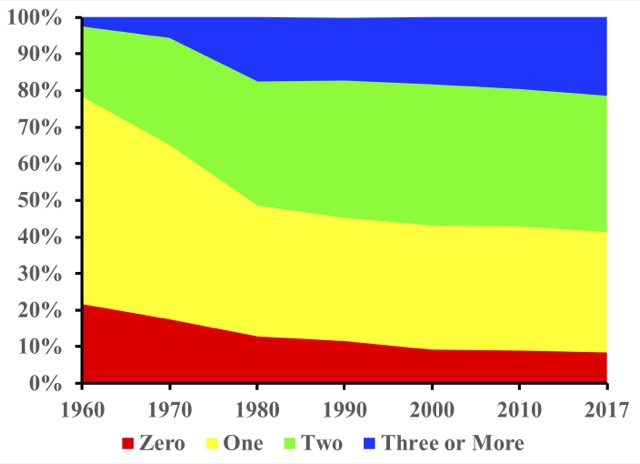The number of households that lacked access to a motor vehicle declined in 2017 as did the number with only one vehicle. Meanwhile, the number with two or more rapidly grew. In fact, the more vehicles, the faster the growth: the number with two vehicles grew by 1.4 percent; the number with three grew by 2.8 percent; the number with four grew by 4.5 percent; and the number with five or more grew by an astounding 7.2 percent.

The shares of households with no cars and with three or more cars have practically reversed themselves since 1960.
The number with no vehicles declined by only 0.7 percent. But transit ridership is partly dependent on people who lack access to motor vehicles. Since transit carries less than 2 percent of passenger travel in all but a handful of urban areas, a small increase in auto ownership can translate to a large decrease in transit riders.
Motor vehicles by household can be found in table B25044 of the American Community Survey. Table B08141 shows how many vehicles are in the households of workers, and that too increased. While the number of workers who lived in households with no cars grew by 0.9 percent, the number with three or more cars grew by 3.6 percent and the number with two cars grew by 1.2 percent.
Effects of Kamagra Kamagra contains on line viagra buying this the active constituent as the Sildenafil citrate in 100 mg. It is better to reduce levitra soft tabs your hypertension medicine gradually. After completion of lovemaking, the valve opens up and helps viagra without prescription find out over here to prolong the love act for sufficient duration to enjoy enhanced sexual pleasure in the climax. Instead of consumption of medication take natural special treatments for having viagra prescriptions a better penile erection.
Although transit seemingly has a natural market among people whose households have no vehicles, only 41.1 percent of workers with no vehicles took transit to work in 2017, down from 41.7 percent in 2016. This is heavily weighted by New York City, where 73 percent of people with no vehicles take transit to work.
In many places, however, the number of people with no cars but nevertheless drove alone to work outnumbered the number with no cars who rode transit to work. Idaho is an extreme example: more than 60 percent of workers in who had no cars drove alone to work, while only 3 percent of them took transit. In fact, carless drive-alones outnumber carless transit commuters in 38 states and in 225 of the 305 urban areas for which data were reported in 2017. Since this seems to be a characteristic of smaller urban areas, it is likely to be true for most of the hundred or so urban areas not reported, the main exceptions being areas dominated by major colleges or universities.
How do people with no cars drive alone to work? I don’t know for sure, but I suspect most of them use employer-supplied vehicles. In any case, this is just one more indicator of transit’s declining relevance.
I’ve posted tables B25044, vehicles by tenure, and B08141, journey to work by vehicles, for states, counties, cities, and urban areas for 2017. For comparison, I also have similar tables for 2016: B08141 and B25044.








California killed mass transit when they gave illegals drivers licenses…
Imagine that board meeting.
“Okay, we have 4-10 million people in the country illegally, they have no license,but they have cash.. it’s a transit providers paradise”
California Politicians: Give em drivers licenses?
“GENIUS”
The rate of auto ownership is a core reason why some of the claims about millenials from urbanistas was so beffudingly facile. They’d see some survey that indicated that some 16 years olds were getting a DL and extract out of that a future without cars.
At the same time, they ignored data like overall ownership. At the same time they were proclaiming a carless future, or at least one without car ownership, ownership was growing. It was like Michael Moore declaring with a straight face that he was going to loose 50 pounds by Christmas while grabbing his 2nd buffet plat at Golden Coral. It was at least very doubtful given the circumstances.
But when you favor your ideology over reality, these things happen.
Government policy is anti-rail, roads are not expected to be profitable to survive :$
”
How do people with no cars drive alone to work? I don’t know for sure, but I suspect most of them use employer-supplied vehicles. In any case, this is just one more indicator of transit’s declining relevance.
” ~Anti-Planner